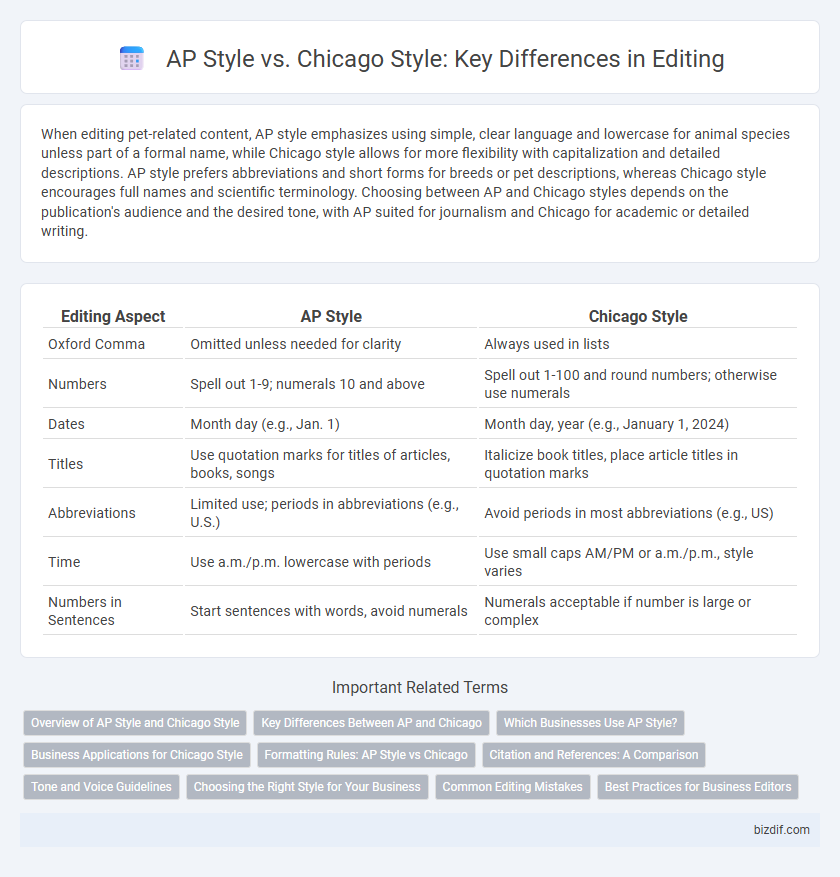When editing pet-related content, AP style emphasizes using simple, clear language and lowercase for animal species unless part of a formal name, while Chicago style allows for more flexibility with capitalization and detailed descriptions. AP style prefers abbreviations and short forms for breeds or pet descriptions, whereas Chicago style encourages full names and scientific terminology. Choosing between AP and Chicago styles depends on the publication's audience and the desired tone, with AP suited for journalism and Chicago for academic or detailed writing.
Table of Comparison
| Editing Aspect | AP Style | Chicago Style |
|---|---|---|
| Oxford Comma | Omitted unless needed for clarity | Always used in lists |
| Numbers | Spell out 1-9; numerals 10 and above | Spell out 1-100 and round numbers; otherwise use numerals |
| Dates | Month day (e.g., Jan. 1) | Month day, year (e.g., January 1, 2024) |
| Titles | Use quotation marks for titles of articles, books, songs | Italicize book titles, place article titles in quotation marks |
| Abbreviations | Limited use; periods in abbreviations (e.g., U.S.) | Avoid periods in most abbreviations (e.g., US) |
| Time | Use a.m./p.m. lowercase with periods | Use small caps AM/PM or a.m./p.m., style varies |
| Numbers in Sentences | Start sentences with words, avoid numerals | Numerals acceptable if number is large or complex |
Overview of AP Style and Chicago Style
AP Style prioritizes brevity and clarity, commonly used in journalism and news writing, emphasizing concise language, consistent abbreviations, and datelines. Chicago Style is preferred in book publishing and academia, offering comprehensive guidelines on grammar, citation formats, and complex punctuation rules to support detailed writing. Both styles serve distinct editorial purposes, with AP Style favoring quick readability and Chicago Style focusing on thoroughness and precision.
Key Differences Between AP and Chicago
AP style prioritizes brevity and clarity, using minimal punctuation and favoring short, direct sentences ideal for news writing, while Chicago style offers more detailed rules suitable for academic and book publishing, including extensive use of serial commas and formal citation formats. AP style uses numerals for most numbers over nine and avoids Oxford commas in lists, whereas Chicago style spells out numbers up to one hundred and consistently employs Oxford commas. Chicago also provides comprehensive guidelines for footnotes and bibliographies, contrasting with AP's preference for in-text attribution and simplified citations.
Which Businesses Use AP Style?
Media outlets, public relations firms, and corporate communications departments predominantly use AP style to ensure clarity and consistency in news writing and press releases. Journalistic organizations like newspapers and magazines prefer AP style for its concise rules tailored to timely reporting. Businesses aiming for public-facing, easily digestible content adopt AP style to maintain professionalism and reader engagement.
Business Applications for Chicago Style
Chicago Style is preferred in business applications for its flexibility in citing diverse sources and accommodating lengthy publications such as reports and white papers. It provides clear guidelines for footnotes and bibliographies, enhancing credibility and professional presentation in corporate documents. This style also supports complex data presentation, making it ideal for business writing that requires detailed explanations and comprehensive referencing.
Formatting Rules: AP Style vs Chicago
AP Style emphasizes conciseness and uses minimal punctuation, such as avoiding the Oxford comma in lists, while Chicago Style favors clarity and includes the serial comma for consistency. AP Style employs quotation marks for titles of articles and chapters, whereas Chicago prefers italics for longer works, including books and movies. In dates and numbers, AP Style opts for simpler formats like "Jan. 1" and spelling out numbers one through nine, contrasting Chicago's preference for full month names and using numerals more broadly.
Citation and References: A Comparison
AP style uses in-text citations with minimal details, typically attributing sources within the text to maintain readability and brevity in journalistic writing. Chicago style provides two systems: author-date citations for in-text referencing and a detailed bibliography for comprehensive source documentation, preferred in academic publishing for clarity and thoroughness. The choice between AP and Chicago style depends on the publication's audience and the required balance between conciseness and detailed citation information.
Tone and Voice Guidelines
AP Style favors a straightforward, concise tone suited for news reporting, emphasizing clarity and neutrality to maintain objectivity. Chicago Style allows for a more flexible, nuanced voice, accommodating varied tones that support in-depth analysis and creative expression in literary and academic writing. Both styles provide detailed guidelines on tone and voice to ensure consistency and appropriateness across different types of content.
Choosing the Right Style for Your Business
Selecting the right style guide for your business depends on your industry and audience, with AP style favored by news organizations for its brevity and clarity, and Chicago style preferred in publishing for its comprehensive approach to grammar and citation. AP style emphasizes simplicity and consistency, making it ideal for fast-paced media environments, while Chicago style offers detailed rules suitable for academic and book publishing. Understanding these differences helps businesses maintain professionalism and enhances communication effectiveness.
Common Editing Mistakes
Common editing mistakes include inconsistent capitalization and abbreviation practices when toggling between AP style and Chicago style, causing confusion in professional writing. AP style favors minimal use of commas and prefers short, concise sentences, whereas Chicago style allows for serial commas and more complex sentence structures. Editors must carefully apply the appropriate style guide rules to maintain clarity and credibility in published content.
Best Practices for Business Editors
Business editors should prioritize consistency and clarity when choosing between AP style and Chicago style, as AP style is preferred for concise, news-related content while Chicago style suits in-depth reports and publications. Accurate application of AP style's emphasis on brevity and active voice improves readability in press releases and corporate communications. Adhering to Chicago style's comprehensive rules on punctuation, citations, and formatting enhances professionalism in business reports and white papers.
AP style vs Chicago style Infographic

 bizdif.com
bizdif.com